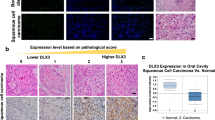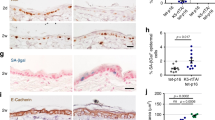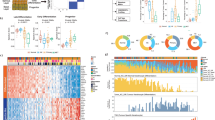Abstract
Basal cell carcinoma (BCC), the most common type of cancer, is characterized by aberrant Hedgehog (Hh) pathway activity. Mutations in pathway components, such as PATCHED1 (PTCH1), are commonly found in BCC. While the tumor suppressor role of PTCH1 in BCC is well established, how Hh pathway activation disrupts normal skin homeostasis to promote BCC formationremains poorly understood. Like Ptc1, Sufu is a major negative regulator of the Hh pathway. Previously, we showed that inactivation of Sufu in the skin does not result in BCC formation. Why loss of Ptc1, but not Sufu, in the epidermis induces BCC formation is unclear. In this report, we utilized gene expression profiling to identify biological pathways and processes that distinguish Sufu from Ptc1 mutants, and discovered a novel role for Sufu in cell cycle regulation. We demonstrated that the Hh pathway activation inSufu and Ptc1 mutant skin is associated with abnormal cell cycle entry, ectopic expression of D-type cyclins and increasedDNA damage. However, despite the presence of DNA damage, p53 stabilization was impaired in the mutant skin. Alternative mechanism to halt genomic instability is the activation of G2/M cell cycle checkpoint, which can occur independent of p53. We found that while Ptc1 mutant cells continue to cycle, which would favor genomic instability, loss of Sufu results in G2/M cell cycle arrest.This finding may explain why inactivation of Sufu is not sufficient to drive BCC formation. Taken together, these studies revealed a unique role for Sufu in G2/M phase progression, and uncovered the molecular and cellular features associated with Hh-driven BCC.
This is a preview of subscription content, access via your institution
Access options
Subscribe to this journal
Receive 50 print issues and online access
$259.00 per year
only $5.18 per issue
Buy this article
- Purchase on Springer Link
- Instant access to full article PDF
Prices may be subject to local taxes which are calculated during checkout




Similar content being viewed by others
References
Ribeiro GR, Francisco G, Teixeira LV, Romao-Correia RF, Sanches JA Jr., Neto CF et al. Repetitive DNA alterations in human skin cancers. J Dermatol Sci 2004; 36: 79–86.
Sardi I, Piazzini M, Palleschi G, Pinzi C, Taddei I, Arrigucci S et al. Molecular detection of microsatellite instability in basal cell carcinoma. Oncol Rep 2000; 7: 1119–1122.
Reifenberger J, Wolter M, Knobbe CB, Kohler B, Schonicke A, Scharwachter C et al. Somatic mutations in the PTCH, SMOH, SUFUH and TP53 genes in sporadic basal cell carcinomas. Br J Dermatol 2005; 152: 43–51.
Hutchin ME, Kariapper MS, Grachtchouk M, Wang A, Wei L, Cummings D et al. Sustained Hedgehog signaling is required for basal cell carcinoma proliferation and survival: conditional skin tumorigenesis recapitulates the hair growth cycle. Genes Dev 2005; 19: 214–223.
Epstein EH. . Basal cell carcinomas: attack of the hedgehog. Nat Rev Cancer 2008; 8: 743–754.
Adolphe C, Hetherington R, Ellis T, Wainwright B . Patched1 functions as a gatekeeper by promoting cell cycle progression. Cancer Res 2006; 66: 2081–2088.
Kasper M, Jaks V, Are A, Bergstrom A, Schwager A, Barker N et al. Wounding enhances epidermal tumorigenesis by recruiting hair follicle keratinocytes. Proc Natl Acad Sci USA 2011; 108: 4099–4104.
Villani RM, Adolphe C, Palmer J, Waters MJ, Wainwright BJ . Patched1 inhibits epidermal progenitor cell expansion and basal cell carcinoma formation by limiting Igfbp2 activity. Cancer Prev Res (Phila) 2010; 3: 1222–1234.
Humke EW, Dorn KV, Milenkovic L, Scott MP, Rohatgi R . The output of Hedgehog signaling is controlled by the dynamic association between suppressor of Fused and the Gli proteins. Genes Dev 2010; 24: 670–682.
Tukachinsky H, Lopez LV, Salic A . A mechanism for vertebrate Hedgehog signaling: recruitment to cilia and dissociation of SuFu-Gli protein complexes. J Cell Biol 2010; 191: 415–428.
Li ZJ, Nieuwenhuis E, Nien W, Zhang X, Zhang J, Puviindran V et al. Kif7 regulates Gli2 through Sufu-dependent and -independent functions during skin development and tumorigenesis. Development 2012; 139: 4152–4161.
Mill P, Mo R, Fu H, Grachtchouk M, Kim PC, Dlugosz AA et al. Sonic hedgehog-dependent activation of Gli2 is essential for embryonic hair follicle development. Genes Dev 2003; 17: 282–294.
Nilsson M, Unden AB, Krause D, Malmqwist U, Raza K, Zaphiropoulos PG et al. Induction of basal cell carcinomas and trichoepitheliomas in mice overexpressing GLI-1. Proc Natl Acad Sci USA 2000; 97: 3438–3443.
Grachtchouk M, Mo R, Yu S, Zhang X, Sasaki H, Hui CC et al. Basal cell carcinomas in mice overexpressing Gli2 in skin. Nat Genet 2000; 24: 216–217.
Mill P, Mo R, Hu MC, Dagnino L, Rosenblum ND, Hui CC . Shh controls epithelial proliferation via independent pathways that converge on N-Myc. Dev Cell 2005; 9: 293–303.
Kenney AM, Rowitch DH . Sonic hedgehog promotes G(1) cyclin expression and sustained cell cycle progression in mammalian neuronal precursors. Mol Cell Biol 2000; 20: 9055–9067.
Kenney AM, Cole MD, Rowitch DH . Nmyc upregulation by sonic hedgehog signaling promotes proliferation in developing cerebellar granule neuron precursors. Development 2003; 130: 15–28.
Abe Y, Oda-Sato E, Tobiume K, Kawauchi K, Taya Y, Okamoto K et al. Hedgehog signaling overrides p53-mediated tumor suppression by activating Mdm2. Proc Natl Acad Sci USA 2008; 105: 4838–4843.
Fan H, Khavari PA . Sonic hedgehog opposes epithelial cell cycle arrest. J Cell Biol 1999; 147: 71–76.
Cooper AF, Yu KP, Brueckner M, Brailey LL, Johnson L, McGrath JM et al. Cardiac and CNS defects in a mouse with targeted disruption of suppressor of fused. Development 2005; 132: 4407–4417.
Goodrich LV, Johnson RL, Milenkovic L, McMahon JA, Scott MP . Conservation of the hedgehog/patched signaling pathway from flies to mice: induction of a mouse patched gene by Hedgehog. Genes Dev 1996; 10: 301–312.
Svard J, Heby-Henricson K, Persson-Lek M, Rozell B, Lauth M, Bergstrom A et al. Genetic elimination of suppressor of fused reveals an essential repressor function in the mammalian Hedgehog signaling pathway. Dev Cell 2006; 10: 187–197.
Ng D, Stavrou T, Liu L, Taylor MD, Gold B, Dean M et al. Retrospective family study of childhood medulloblastoma. Am J Med Genet A 2005; 134: 399–403.
Aszterbaum M, Epstein J, Oro A, Douglas V, LeBoit PE, Scott MP et al. Ultraviolet and ionizing radiation enhance the growth of BCCs and trichoblastomas in patched heterozygous knockout mice. Nat Med 1999; 5: 1285–1291.
Mancuso M, Pazzaglia S, Tanori M, Hahn H, Merola P, Rebessi S et al. Basal cell carcinoma and its development: insights from radiation-induced tumors in Ptch1-deficient mice. Cancer Res 2004; 64: 934–941.
Nieuwenhuis E, Motoyama J, Barnfield PC, Yoshikawa Y, Zhang X, Mo R et al. Mice with a targeted mutation of patched2 are viable but develop alopecia and epidermal hyperplasia. Mol Cell Biol 2006; 26: 6609–6622.
Oro AE, Higgins K. . Hair cycle regulation of Hedgehog signal reception. Dev Biol 2003; 255: 238–248.
Grachtchouk V, Grachtchouk M, Lowe L, Johnson T, Wei L, Wang A et al. The magnitude of hedgehog signaling activity defines skin tumor phenotype. EMBO J 2003; 22: 2741–2751.
Subramanian A, Tamayo P, Mootha VK, Mukherjee S, Ebert BL, Gillette MA et al. Gene set enrichment analysis: a knowledge-based approach for interpreting genome-wide expression profiles. Proc Natl Acad Sci USA 2005; 102: 15545–15550.
Merico D, Isserlin R, Stueker O, Emili A, Bader GD . Enrichment map: a network-based method for gene-set enrichment visualization and interpretation. PLoS ONE 2010; 5: e13984.
Howell BG, Solish N, Lu C, Watanabe H, Mamelak AJ, Freed I et al. Microarray profiles of human basal cell carcinoma: insights into tumor growth and behavior. J Dermatol Sci 2005; 39: 39–51.
O'Driscoll L, McMorrow J, Doolan P, McKiernan E, Mehta JP, Ryan E et al. Investigation of the molecular profile of basal cell carcinoma using whole genome microarrays. Mol Cancer 2006; 5: 74.
Welss T, Papoutsaki M, Michel G, Reifenberger J, Chimenti S, Ruzicka T et al. Molecular basis of basal cell carcinoma: analysis of differential gene expression by differential display PCR and expression array. Int J Cancer 2003; 104: 66–72.
Gambichler T, Skrygan M, Kaczmarczyk JM, Hyun J, Tomi NS, Sommer A et al. Increased expression of TGF-beta/Smad proteins in basal cell carcinoma. Eur J Med Res 2007; 12: 509–514.
Lange D, Persson U, Wollina U, ten Dijke P, Castelli E, Heldin CH et al. Expression of TGF-beta related Smad proteins in human epithelial skin tumors. Int J Oncol 1999; 14: 1049–1056.
Van Haren R, Feldman D, Sinha AA . Systematic comparison of nonmelanoma skin cancer microarray datasets reveals lack of consensus genes. Br J Dermatol 2009; 161: 1278–1287.
Barnes EA, Kong M, Ollendorff V, Donoghue DJ . Patched1 interacts with cyclin B1 to regulate cell cycle progression. EMBO J 2001; 20: 2214–2223.
Takizawa CG, Morgan DO . Control of mitosis by changes in the subcellular location of cyclin-B1-Cdk1 and Cdc25C. Curr Opin Cell Biol 2000; 12: 658–665.
Gorgoulis VG, Vassiliou LV, Karakaidos P, Zacharatos P, Kotsinas A, Liloglou T et al. Activation of the DNA damage checkpoint and genomic instability in human precancerous lesions. Nature 2005; 434: 907–913.
Bartkova J, Horejsi Z, Koed K, Kramer A, Tort F, Zieger K et al. DNA damage response as a candidate anti-cancer barrier in early human tumorigenesis. Nature 2005; 434: 864–870.
Cwinn MA, Mazerolle C, McNeill B, Ringuette R, Thurig S, Hui CC et al. Suppressor of fused is required to maintain the multipotency of neural progenitor cells in the retina. J Neurosci 2011; 31: 5169–5180.
Acknowledgements
We thank E Nieuwenhuis and W Nien for initial characterization of the Sufu and Ptc1 mutants, and T Satkunendran for technical help. This research is funded by the Canadian Cancer Society Research Institute (2011-700774) to CCH.
Author information
Authors and Affiliations
Corresponding author
Ethics declarations
Competing interests
The authors declare no conflict of interest.
Additional information
Supplementary Information accompanies this paper on the Oncogene website
Rights and permissions
About this article
Cite this article
Li, Z., Mack, S., Mak, T. et al. Evasion of p53 and G2/M checkpoints are characteristic of Hh-driven basal cell carcinoma. Oncogene 33, 2674–2680 (2014). https://doi.org/10.1038/onc.2013.212
Received:
Revised:
Accepted:
Published:
Issue Date:
DOI: https://doi.org/10.1038/onc.2013.212
Keywords
This article is cited by
-
Elevated Hedgehog activity contributes to attenuated DNA damage responses in aged hematopoietic cells
Leukemia (2020)
-
Vitamin C promotes the proliferation and effector functions of human γδ T cells
Cellular & Molecular Immunology (2020)
-
Differing tumor-suppressor functions of Arf and p53 in murine basal cell carcinoma initiation and progression
Oncogene (2017)
-
Inefficient differentiation response to cell cycle stress leads to genomic instability and malignant progression of squamous carcinoma cells
Cell Death & Disease (2017)
-
Hedgehog signaling: modulation of cancer properies and tumor mircroenvironment
Molecular Cancer (2016)



